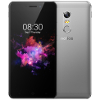UleFone Future vs TP-LINK Neffos X1 Max
Quelle est la différence entre UleFone Future et TP-LINK Neffos X1 Max. Découvrez quel smartphone offre les meilleures performances.
Performance (Benchmarks)
| 421 | 3DMark for Android Sling Shot Extreme (OpenGL ES 3.1 / Metal) | 404 |
| 600 | 3DMark for Android Sling Shot | 583 |
| 3262 | PCMark for Android Work 2.0 | 3328 |
Caractéristiques
| UleFone Future | Nom du produit | TP-LINK Neffos X1 Max |
| Android 6.0 | Système d'exploitation (OS) | Android 6.0 |
| Bluetooth WLAN | Réseaux sans fil | Bluetooth WLAN |
| Yes, Type-C | Interfaces / connecteurs | Yes, microUSB 2.0 |
Ecran
| 1920 × 1080 px | Résolution d'écran | 1920 × 1080 px |
| LTPS | Type d’écran | IPS LCD |
| Yes | Multipoints (multitouch) capacitif | Yes |
| 5.5" | Taille écran | 5.5" |
Processeur (CPU)
| Up to 2.0 GHz quad-core ARM Cortex-A53 and 1.2 GHz quad-core ARM Cortex-A53 | Architecture CPU | Up to 2.0 GHz quad-core ARM Cortex-A53 and 1.2 GHz quad-core ARM Cortex-A53 |
| MT6755 | Processeur | MT6755 |
| Mali-T860 MP2 | GPU | Mali-T860 MP2 |
Mémoire
| 4096 MB | Mémoire RAM | 3072 / 4096 MB |
| 32 GB | Capacité de stockage (ROM) | 32 / 64 GB |
| microSD | Carte mémoire | microSD / microSDHC / microSDXC |
Appareil photo
| Yes, 16 MP | Capteur photo | Yes, 13 MP |
| Yes, 5 MP | Capteur photo avant | Yes, 5 MP |
Communication
| GSM 850 / 900 / 1800 | 2G | GSM 850 / 900 / 1800 / 1900 |
| HSDPA 900 / 2100 | 3G | HSDPA 850 / 900 / 2100 |
| LTE 800 / 1800 / 2100 / 2300 / 2600 | 4G (LTE) | varies by model |
Géolocalisation
| Yes | GPS | Yes |
| Yes | A-GPS | Yes |
Batterie
| 3000 mAh | Capacite de la batterie | 3000 mAh |
Design
| 73.5 / 151.5 / 8.6 mm | Dimensions | 76 / 152.8 / 7.8 mm |
| 185 g | Poids | 148 g |

